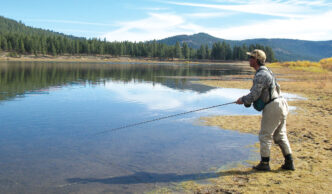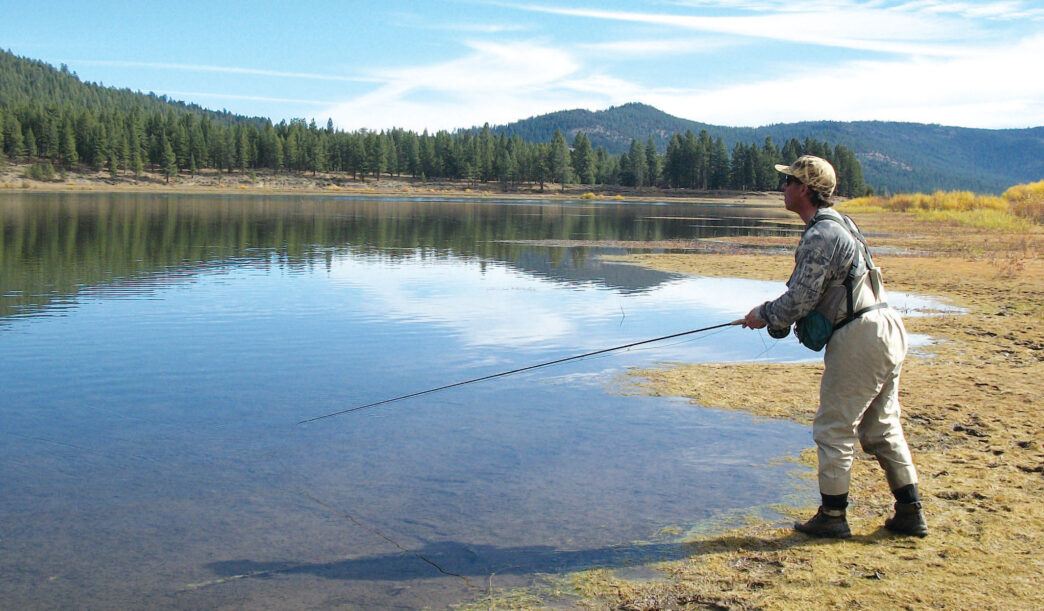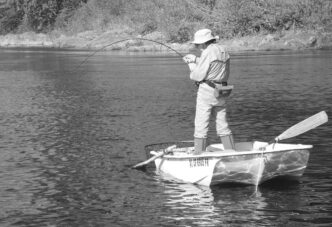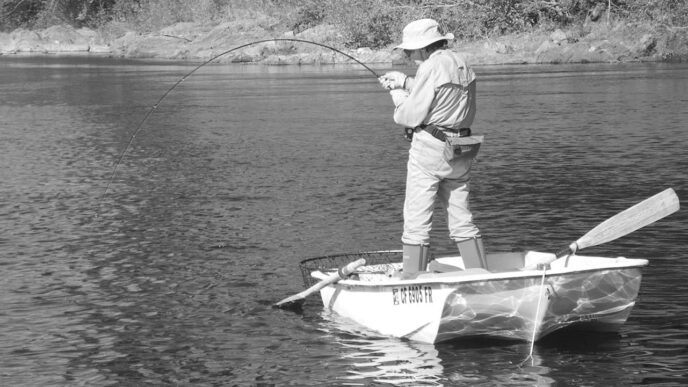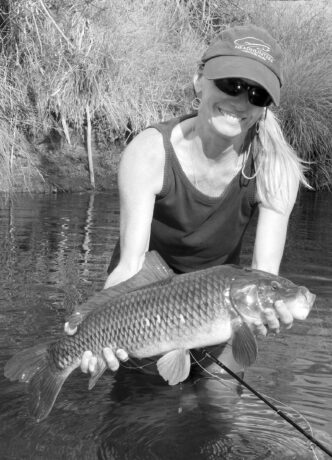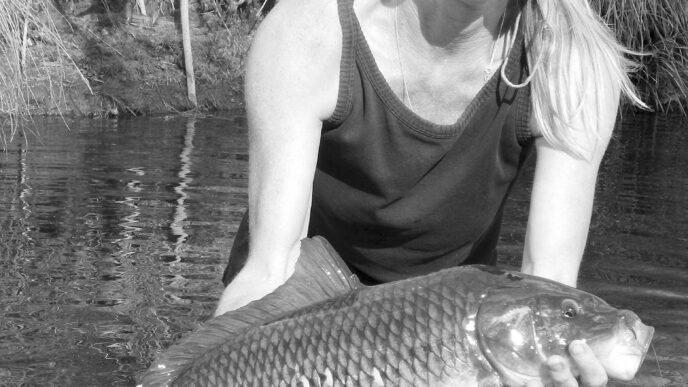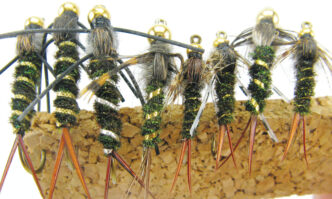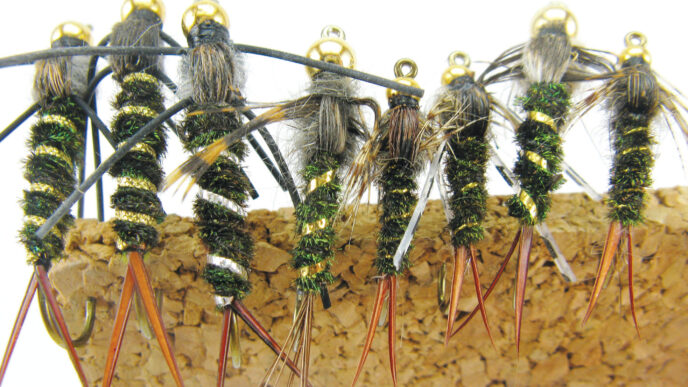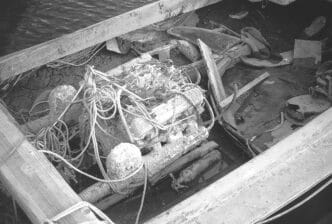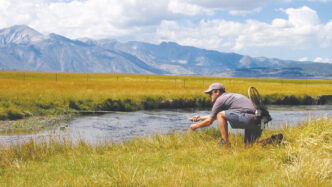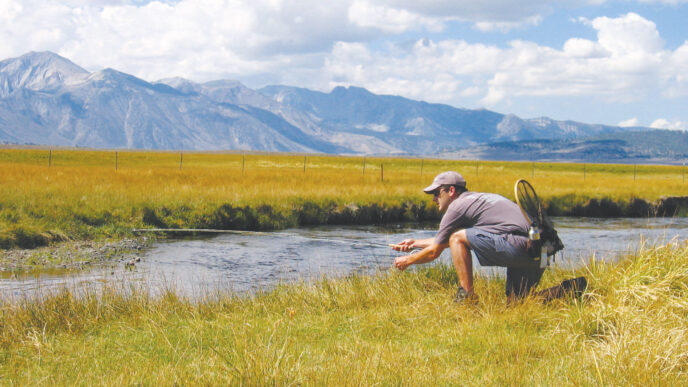I felt its presence, as all animals do at this time of year. Spring was in the air. In the sagebrush off the dusty spur road, I rigged my rod and took my time getting prepared. The land around me was quiet, without a puff of wind: complete bliss, with no other anglers casting in the distance, either. There was just the sun shining down on me, providing a blanket of warmth and security, now that winter had ended. The walk to the lake’s productive shoals and flats was not that far, and it gives a trout stalker a little time to ponder and make a game plan for the day. When I reached the point with the lone pine, I took my day pack off, leaned up against the old, withered tree, and scanned the water’s surface, searching for any disturbance or rise forms.
Dimples were forming here and there above-submerged weed beds: blood midges had started their daily emergence routine. Soon I saw my first target rising steadily down the shoreline, feeding in less than two feet of water with the pace of a grazing cow. I was in no hurry. These were moments to savor.
I began a careful approach to the water’s edge, seeking the perfect position to intercept my quarry. I crept slowly, then knelt to the ground, made my presentation, pulled in the slack, and gave the fly a twitch, sending the slightest of ripples to get the attention of the fish. Without a sound, the large head of the rainbow appeared and elegantly inhaled my fly. I whispered softly the traditional phrase recited to prevent an excited angler from setting the hook too soon: “God save the queen.” Then I jerked my rod up and my line back, and the peaceful cove exploded. Stalking stillwater trout from the shore is a simple, yet effective approach to fly fishing a lake, with no special tackle requirements other than a keen eye and a steady hand. And stalking trout from the shore involves the angler’s mind and body much more than just sitting in a float tube and watching an indicator. You’re hunting a wild animal, repressing all that the modern world has taught you and letting your instincts as a predator take over.
The Seasons of Opportunity
The time of year dictates when trout become accessible in shallow water to the shorebound trout stalker. Water temperatures and the availability of food are the two most important factors. In the late spring, the opening ceremonies begin when water temperatures reach the mid 50s and damselflies, blood midges, and Callibaetis mayflies begin dancing in the breeze. The time of day is important, too, and in the spring, the middle of the day tends to be best, because this is when aquatic insects begin to get active and rise up in the water column to hatch.
As spring becomes summer, however, the trout usually move into the shallows only from morning to early afternoon and during the last few hours of light. Again, active hatches and water temperatures dictate feeding times for the trout. Even in the extremely warm water later in the summer, these fish will come into the shallows and feed for a few hours from first light to mid-morning, and again during the last few hours of light in the evening. Trout in lakes are opportunistic — they have to be, because they’re often big fish and thus must feed heavily, no matter the circumstances or dangers to them, so even with water temperatures approaching 70 degrees, they still search the shallows for prey. For the survival of any trout you hook in warmer water, however, it is imperative that you play it quickly and release it without any added stress, including opting out of taking a photograph of your prize.
As the days of summer shorten and the sun’s arc across the sky gets noticeably lower, water temperatures begin to drop. I relish autumn more than any other season, because this is when the trout gorge themselves for the coming winter, and the best fishing takes place. In the fall, the fish do not come and go from the shallows, as they do in the early spring and through the summer. They linger there, and great fishing can happen all day long. The trout also become very dumb and aggressive. If you feel a take and miss your hook set, you will get many more chances if you do not pull your fly out of the strike zone. This circus continues until shore ice starts to form and the lakes begin locking up for their deep sleep through the winter months. This can happen early or late in the fall, depending on the weather.

Tactics
In lakes, as a general rule, 10 percent of the habitat holds 90 percent of the fish, so stalking trout from shore begins with finding where trout prefer to feed just off the shoreline. The best areas in a lake have flats extending out from the shore with water depths of two to six feet. The most productive flats are found next to prolific weed beds and channels or submerged creek beds. The fish use the depth of the channels and creek beds for cover and to digest their food safely after feeding in the shallows. In the warmer months, they also use these areas to dine all day, because that is where the water temperature will usually be cooler. Looking at the surrounding shoreline above the water will often reveal the characteristics of the bottom structure offshore. Points, creeks, channels, and springs that spill cooler water will attract trout because they offer either usable structure for feeding or comfort.
Once the stalking fly fisher has identified promising flats, the next objective is to find pods of actively feeding trout. Casting less and observing more is crucial to success. Often, just scanning the shoreline and coves with a pair of high-powered binoculars can show you feeding fish.
After you’ve found the quarry, the hunt begins, and it’s no different from stalking any other kind of wild animal. Keep a low profile, walk softly, and wear colors that blend in with the natural surroundings. When cruising fish are feeding, it’s a matter of figuring out their direction of movement and speed. Your cast should be in the path of the fish you are targeting and far enough ahead for it to intercept the fly naturally. If fishing subsurface, know the sink rate of your fly so it’s in the strike zone at the right time. Too heavy of a fly will sink below cruising fish, or even worse, hang up on the bottom.
Sometimes trout will feed very close to shore, which means you should be on your knees so as not to spook them with a large, looming silhouette. Fishing on hands and knees, with only your leader and a few feet of fly line out, is special, because being that close to your quarry without detection is a rush. It’s what trout stalking is all about.
If you’re lucky enough to locate a pod of trout and have hooked a few, stay put and keep fishing until the action wanes. When that happens, by moving down the shoreline, even as little as 30 feet, you often can locate the actively feeding pod again. Just like people, trout don’t like to get picked on, and will move to seek respite from your attentions. Your goal is simple: move with them.
Sometimes, of course, there is no visible sign of any actively feeding fish. In that case, instead of sight fishing, you’re blind casting. That can be exciting, too. I start making very short casts — 15 to 25 feet offshore — while standing at the water’s edge. You never know what’s going to be lurking tight to the bank, and it would be a terrible thing to trot out into knee-deep water, only to spook a large rainbow.
Fan casting from all angles and covering the water is the only sure way to know what’s out there when casting blind. Once you have thoroughly covered the skinny water, it’s time to wade out a little and extend your cast from 30 to 50 feet, again fan casting and covering even more water. You’ll be fishing deeper water now, and must present the fly at different depths, starting in the upper water column and probing deeper with each series of fan casts.
Wind-whipped waves make sighting fish difficult, and fish stalkers often call it a day at the first sign of wind. I’ve had many encounters with rising trout in flat, calm water end with the onset of a stiff breeze. There are options though, including searching for what I call a “soft window.” This is the calm water in the lee of a windbreak, inshore of the wind-ruffled water. Pods of trout that are seeking security, but also a chance to feed, cruise the edge or fringe between the soft window and the choppy water, using the chop as cover. At Lake Davis, for example, the many coves and fingers that stretch out from the west and north shores shelter the water’s surface from the wind. Large patches of willows on the windward side of a shoreline also can create shelter from the wind. In these sheltered areas, the water will be smooth as glass — like a window. Trout are spooky when using the edge of the soft window for cover, so stalkers must keep movement and shadows to a minimum. Kneeling down in front of the willows and waiting for the magic to happen will reward the angler who has patience.
Equipment
Your weapon of choice for trout stalking can’t be any simpler. A 5-weight or 6-weight rod matched with a large-arbor reel with a reliable drag system for fighting fish and picking up line quickly is ideal, but just use what is most comfortable and works best for you. For lines, my choice is a weight-forward floater in an olive color that blends in well with the natural environment. I seldom use an intermediate line when fishing off the bank, except in very windy conditions, when I need to get the fly and line down through the choppy water. Long leaders, from 9 to 13 feet, are the norm — many companies now offer long, tapered leaders ready to go. My formula for a long leader is to run 2 to 4 feet of .024-inch butt material off my fly line, then add a 9-foot leader tapering down to 4X. For smaller dries, 5X tippets may be needed, but they’re on the light side for the kind of fish you may encounter. During the fall, when trout are gorging unwarily, tippet size is not a concern, and you can get away with using heavier tippets, such as to 3X.
In general, the flies you choose should have the right profile, size, movement, and color. Both aquatic insect imitations and attractors work well when stalking stillwater trout. When matching the hatch, it’s best to capture a live specimen and make a fly selection that’s as close as you can to the real thing. I can’t say this enough: cast less and observe fish and insect activity more. Every day’s hatch is different, especially with damselflies, whose colors and sizes change throughout the length of their emergence over several months.
Many of the nymph imitations and other wet flies that I fish with are tied on heavy scud hooks, size 10 to 12, for strength and hooking power. Incorporating moving parts in your wet fly helps the fly come alive and look like a living aquatic insect. Marabou does that, but its natural fibers are also very fragile and easily damaged. Using rabbit hair cut from packaged Zonker strips and tied in sparsely is the answer for creating more durable tails, gills, and legs.
For anglers who do not tie, there are imitations that work very well that can be bought over the counter. They include Sheep Creek Specials, size 10 to 14, GoldRibbed Hare’s Ear Nymphs with a very small gold bead, size 12 to 16, Poxyback Scuds in brown and in olive, size 12 to 16, and Rabbit Hair Leeches in black and in rust, size 8 to 12.
Dry flies should float well and be highly visible, because if you can’t see your fly, you’ll be guessing its location and unprepared when a fish takes it. White foam or high-visibility parachute posts help locate your fly in the water’s glare or chop. Once again, observing the hatch and capturing a natural will help in selecting the correct fly for the occasion. Parachute Adamses, size 14 to 16 for Callibaetis mayflies, and Quigley Cripples in burnt orange, size 12 to 14 for blood midges, are two top-producing dry-fly patterns when targeting risers in skinny water.
Attractor flies should have plenty of moving parts, as well. These flies can imitate a number of different food items found in still waters. My attractor fly of choice is Jay Fair’s Wiggle Tail Nymph in brown, olive, and burnt orange, size 10 to 12. Other productive colors can include black, cinnamon, rust, and bright green. A good assortment of attractor flies would also include Woolly Buggers, size 10 to 14 in the same colors.
When stalking trout in stillwater shallows, no subsurface fly, whether imitation or attractor, should be too heavy. As you to probe the shallows, you need to keep the fly just off the bottom or right in a trout’s path. The damsel imitation I tie for shallow water has a large, closed-cell foam head that gives it neutral buoyancy, so it remains in the upper water column. During pauses in the retrieve, this fly hovers in the strike zone, instead of dropping to the bottom — something to consider when tying your own flies for shallow-water presentations.
Retrieves should match the natural movement of the foods that stillwater trout eat. Damselflies are very slow and like to rest as they swim toward the shoreline and exposed weed beds for emergence, so making very slow, short, one-inch strips with plenty of pauses is the way to go. For Callibaetis mayfly nymphs, quicker and longer retrieves work best to mimic the natural movement of these aquatic insects. Study insect behavior both above and below the surface and you will better understand how to move your fly correctly, resulting in more fish hooked. When in doubt, a slow hand crawl with plenty of pauses is a proven retrieve.
All of us have an objective when playing the game of fly fishing: tallying numbers of fish caught, or biggest fish, or number of species. But for some of us, there is nothing better than the challenge of being on the hunt and sight fishing to large trout in Western still waters.
Eagle Lake, Lake Davis, and Frenchmans Reservoir
In Northern California, we are blessed to have lakes that allow fly fishers to stalk fish in shallow water from the shore. For stalking stillwater trout, it’s hard to beat Eagle Lake, Lake Davis, and Frenchmans Reservoir, impoundments that I am very familiar with as a guide. There are many others, some less talked about and some that no wise angler ever mentions, but these three popular lakes are very accessible and can be quite productive.
With over a 100 miles of shoreline, northeastern California’s Eagle Lake is the second-largest body of water in the state and the home of a special strain of trout: the Eagle Lake rainbow. Thousands of years ago, Eagle Lake was part of Lake Lahontan, the huge lake that during the Pleistocene era covered what is now northwestern Nevada, northeastern California, and southern Oregon. Then volcanic activity and a rising landscape sealed off the Eagle Lake basin, leaving behind a hybrid of the Pit River rainbow and the Lahontan cutthroat trout. Only this special trout can survive in Eagle’s high-alkalinity water. Aquatic insects flourish there, as well, along with freshwater shrimp, which are the staple food source for the trout.
This lake is so vast that finding the fish is more important than presentation and fly selection. Situated in a beautiful basin, the west side of the lake is shrouded in pines, while stretching out to the east, sage and juniper pines fill the high-desert terrain. Catching an Eagle Lake rainbow is a goal for all fly anglers who seek the ultimate stillwater experience in a remote setting. Tip: fishing a productive shoal, flat, or rock pile at first legal light is essential as the Eagle Lake rainbow is an early feeder.
Lake Davis was born when Grizzly Creek was dammed to supply the water needs of California’s ever-increasing population and agricultural interests. Located a little over an hour north of the Lake Tahoe basin, it is a very popular year-round recreation area. With its large biomass, fertile weed beds, and rich shallows, this lake was just meant to be fished with a fly rod. Located at an elevation of 5,700 feet and surrounded by a lush coniferous forest with willows and pristine native grasses, Lake Davis is absolutely gorgeous. The stocked rainbow trout grow fast on a diet that consists mostly of chironomids, including giant blood midges, and of course damselflies. The lake has been treated twice in the last 15 years to exterminate illegally introduced northern pike, and because of this, its snail population has been decimated, depriving the trout of that food source. As a result, the trout are on the small side, compared with those of prior years. Despite the loss of the snails, Lake Davis remains a top destination for stillwater fly anglers from across the state and beyond. Tip: watching shoreline bird activity during the damsel hatch can reveal the best areas to focus your presentations, as California gulls often line the banks to feed upon emerging nymphs.
Frenchmans Reservoir is Lake Davis’s little sister, and all the same techniques, tactics, and fly selections that work at Davis work there, as well. Even the species of aquatic insects are the same, except that Frenchmans still has an abundant snail population. The lake is a flooded meadow with submerged creek beds, and though it is deeper in spots than Davis, it still has fertile shallows that can be fished from the shore. The rainbow trout here are smaller than at Davis, but the catch rates can be high. Early and late in the season are the best times at Frenchmans to avoid the water-sports hatch, with November and December being very productive. Tip: the top producing fly here is George Bigg’s Sheep Creek Special with a peacock body fished with an intermediate or floating line.
Jon Baiocchi



